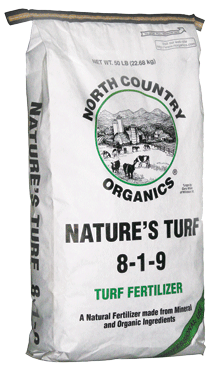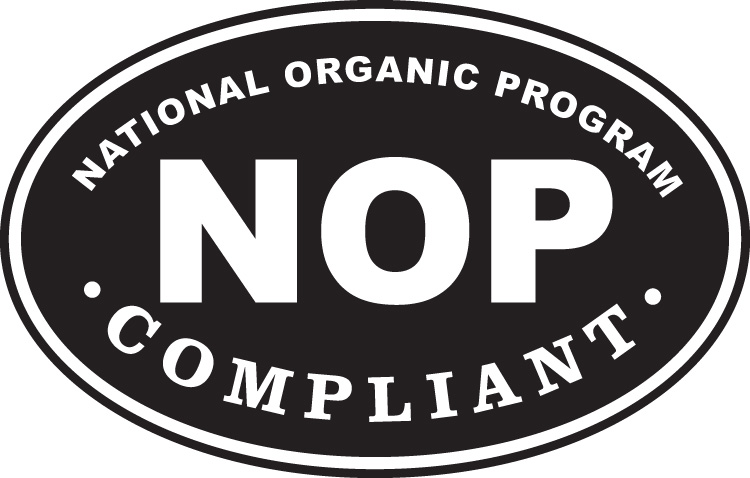
Nature’s Turf 8-1-9
 Nature’s Turf 8-1-9 is a designer fertilizer made specifically for turf. The objective of Nature’s Turf 8-1-9 is to provide nutrients to turf plants in the most efficient manner possible, and the best way to accomplish that is to enliven and enrich the biological activity in the soil. More and more researchers, scientists, and turf managers are beginning to recognize the awesome value of a biologically active soil. Soil organisms are responsible for so many functions that directly benefit turf. Almost all of the nutrients utilized by plants-especially those obscure but essential elements that are not normally added to conventional fertilizer-are made available to plants by soil organisms. One of the most important and essential nutrients for all plants is carbon dioxide, which would not be available in ample quantities if it weren’t for the work of soil organisms. All the proteins and carbohydrates manufactured by photosynthesis are built upon a base of carbon supplied by carbon dioxide. Saprophytic organisms in the soil produce carbon dioxide as they consume organic residues.
Nature’s Turf 8-1-9 is a designer fertilizer made specifically for turf. The objective of Nature’s Turf 8-1-9 is to provide nutrients to turf plants in the most efficient manner possible, and the best way to accomplish that is to enliven and enrich the biological activity in the soil. More and more researchers, scientists, and turf managers are beginning to recognize the awesome value of a biologically active soil. Soil organisms are responsible for so many functions that directly benefit turf. Almost all of the nutrients utilized by plants-especially those obscure but essential elements that are not normally added to conventional fertilizer-are made available to plants by soil organisms. One of the most important and essential nutrients for all plants is carbon dioxide, which would not be available in ample quantities if it weren’t for the work of soil organisms. All the proteins and carbohydrates manufactured by photosynthesis are built upon a base of carbon supplied by carbon dioxide. Saprophytic organisms in the soil produce carbon dioxide as they consume organic residues.
Many soil organisms are responsible, both directly and indirectly, for suppressing a large number of turfgrass diseases, not to mention phytopathogenic nematodes and some herbivorous insects. Many disease pathogens, in fact, exist as saprophytic organisms feeding on organic residues in the soil. It isn’t until those residues are depleted that they become parasitic and cause plant disease. Maintaining resources for soil organisms is always in the best interest of the turf manager. Other benefits of a biologically active soil include soil aggregation, thatch reduction, more efficient release of available plant nutrients, improved soil atmospheric respiration, systemic acquired disease resistance, antioxidant hormone production, improved water infiltration, increased water and oxygen holding capacity, deeper and more extensive turf roots, mycorrhizal associations, reduced soil compaction, and improved turf density with consequent weed suppression.
The eight- percent nitrogen (N) in Nature’s Turf 8-1-9 is derived from three different sources that all have different release rates. Most of the nitrogen is organic and feeds populations of bacteria that require high protein substrates to multiply. A small amount of the nitrogen in Nature’s Turf 8-1-9 is derived from a soluble, natural mineral source that will provide N to plants even when the soil is cold and biological activity is naturally suppressed.
Phosphorus (P) is a nutrient that is very important to germinating seeds but established turf rarely needs much more than what is already in the soil. Unless a soil test indicates a need for phosphorus, excessive applications of P may only serve to increase the germination of annual weed seeds. The low amount of phosphorus in Nature’s Turf 8-1-9 can significantly reduce the need for herbicides.
Potassium (or potash) is extremely important for plant strength and health. The plant’s ability to defend against both insect and disease pests and its tolerance to heat, cold, drought, and wear depend on adequate absorption of potassium. Without sufficient potassium, cell walls become thin, weak, and less able to retain fluids. This condition makes plants easier prey for insect and disease organisms and less able to withstand traffic or survive through the winter. Potassium ions available to plant roots are magnetically attached to colloidal soil particles such as clay and humus. The abundance of these particles and their ability to hold positively charged ions (cations) makes up, what is known as, the cation exchange capacity (CEC) of the soil. The higher the CEC, the more cations like potassium, magnesium, and calcium can be held by the soil. Unfortunately, the type of soil (sandy) in which turf, especially sports turf, is often growing has a low CEC and often cannot hold enough potassium ions necessary for adequate cell turgor. Nature’s Turf 8-1-9 is designed to compensate for a low CEC and provide the extra potash needed to grow strong, resilient plants.
Nature’s Turf 8-1-9 is manufactured in consistently sized granules that spread evenly and integrate easily into the turf canopy. We always recommend mowing with the bag off but it is especially important for the first 2-3 mowings after Nature’s Turf 8-1-9 has been applied. Clippings can contribute up to two pounds of nitrogen, increase earthworm populations, decrease thatch, improve water infiltration, increase root mass, and suppress turf diseases.
Application Rates
Application rates vary from 3 to 12 pounds per 1000 ft2 depending on soil conditions and the preferences of the turf manager. If turf is growing on biologically inactive soil*, we would recommend greater application rates less frequently. Once biological activity is restored, lower rates can be used but should be applied more often. Nature’s Turf 8-1-9 should be applied during periods of the season when grass normally grows vigorously. Fertilization during periods when grass is naturally dormant may fuel weed growth. Nature’s Turf 8-1-9 can be applied as a dormant feeding in the late fall but fertilizers, in general, should not be applied after dormancy in areas prone to winter diseases. A late summer/early fall application can help soil organisms provide suppression of many winter disease organisms. Nature’s Turf 8-1-9 should be applied when turf shows signs of infertility. Coverage: 4000 – 16,000 ft2 per 50-lb. bag. Product density: 43 lbs. per ft3.
Nature’s Turf – View MSDS (pdf)
 North Country Organics
North Country Organics